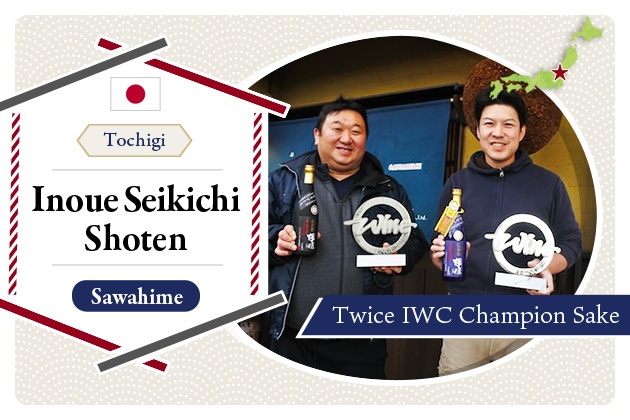
2025.07
09
What is “Sake Meter Value”? Explaining the Differences Between Plus and Minus, Sweet and Dry
The “Sake Meter Value” (SMV), or Nihonshudo, is a figure often found on the back label of a sake bottle. It’s commonly described as an indicator of whether a sake tastes sweet or dry. However, as many enthusiasts and professionals know, the relationship isn’t quite so simple—SMV alone doesn’t fully explain a sake’s perceived sweetness or dryness.
In this article, we take a closer look at SMV as a starting point, while also exploring other key factors that influence flavor perception. By examining these elements together, we aim to better understand how the sweetness or dryness of a sake is truly determined.
What Is the Sake Meter Value (SMV)?
The Sake Meter Value (SMV), or Nihonshudo in Japanese, is a number commonly used as a rough guide to indicate whether a sake leans sweet or dry. Generally, values between -1.4 and +1.4 are considered “neutral” (note 1). Sake with lower (more negative) SMV values is said to taste sweeter, while higher (more positive) values are associated with drier profiles.
Note 1: Definitions of “neutral” SMV vary; some sources consider ±0 as neutral, while others extend the range up to +5.
While SMV serves as a guideline for sweetness or dryness, it does not directly reflect the sugar content of the sake. Instead, SMV measures the specific gravity of the liquid.
SMV is determined using a device called a sake hydrometer. This instrument is calibrated so that its reading is 0 when placed in pure water at 4°C (39.2°F). When floated in a sake sample, it will show a positive value if the sake is lighter than water, and a negative value if it is heavier.
But why does the specific gravity of sake serve as an indicator of sweetness or dryness? The answer lies in understanding the fermentation process.
During fermentation, yeast converts sugar into alcohol. Sugar is denser than water, whereas alcohol is lighter. As fermentation progresses, more sugar is broken down and replaced by alcohol, reducing the sake’s overall density. Therefore, a high SMV (lighter liquid) typically indicates that more sugar has been consumed, suggesting a drier taste. Conversely, a lower SMV (heavier liquid) implies more residual sugar, and thus a sweeter profile.
In short, SMV was originally developed as a way to monitor the degree of fermentation during production—but over time, it also came to serve as a general indicator of perceived sweetness or dryness in sake.
Other factors influencing sweetness and dryness
SMV alone does not determine whether a sake tastes sweet or dry. In sake evaluation, the term “dry” (karakuchi) can imply not only low sweetness, but also a crisp, clean finish. To gain a fuller understanding of flavor perception, we must also consider additional elements—starting with acidity.
Acidity (San-do)
Acidity is one of the most influential factors affecting a sake’s perceived dryness. In general, the higher the acidity, the drier the sake tends to taste.
Acidity refers to the total amount of organic acids present in the sake. Most sakes fall within the range of 0.5 to 3.0, with a median value of about 1.4 to 1.6 considered balanced.
So how does acidity influence sweetness or dryness? First, acidity contributes to a sake’s kire—the crisp, sharp finish that often characterizes drier styles. Second, acidity and sweetness tend to counterbalance one another on the palate. As a result, even if a sake has a relatively low SMV (which would suggest sweetness), high acidity can make it taste noticeably drier.
In 1974, researchers developed a formula known as the Karakuchi Index (Amakarado) to quantify sweetness and dryness by combining SMV and acidity:
Karakuchi Index = {193593 ÷ (1443 + SMV)} − (1.16 × Acidity) − 132.57
Based on this formula:
–3 = Extra dry
–2 = Dry
–1 = Medium dry
0 = Average
+1 = Medium sweet
+2 = Sweet
+3 = Extra sweet
However, this formula has limitations. For example, if a sake has an SMV of +12 and an acidity of 1.6—values typical of a commercially available dry sake—the Karakuchi Index only comes out to about –1.37, which classifies it as only “slightly dry.”
To better reflect the sweetness/dryness spectrum of modern sake, a revised formula called the New Karakuchi Index was introduced in 2004:
New Karakuchi Index = Glucose content (g/100ml) − Acidity (ml)
Based on this index:
≤ 0.2 = Dry
0.3–1.0 = Medium dry
1.1–1.8 = Medium sweet
≥ 1.9 = Sweet
This newer method allows for broader and more accurate classification across a wide range of sake styles.
Ultimately, the fact that both formulas incorporate acidity highlights just how critical it is in shaping the perception of sweetness or dryness.
Acidity also plays a role—alongside amino acid content—in determining a sake’s texture and richness. Higher acidity and amino acid values tend to produce full-bodied (noujun) sake, while lower values result in a light and clean (tanrei) profile. For more on acidity and amino acids, see our in-depth article.
Bitterness, astringency, and effervescence
Bitterness, astringency, and effervescence (perceived carbonation) are all elements that can enhance the perception of dryness in sake. Like acidity, these are considered stimulating components in the flavor profile.
On the other hand, sweetness and umami are often associated with smoothness and roundness on the palate.
When stimulating elements outweigh the smooth, mellow qualities of sweetness and umami, the sake tends to be perceived as dry. Conversely, when the smooth elements dominate, the sake is more likely to be experienced as sweet.
In this sense, the perception of sweetness or dryness is not defined by a single factor but is the result of a dynamic balance between stimulating and softening flavor components.
So, how should you choose between sweet and dry sake?
Looking for Dry Sake
If you prefer your sake on the dry side (karakuchi), here are some key indicators to help guide your selection:
Look for higher alcohol content Alcohol content plays a significant role in how dry or sharp a sake tastes. Generally, the higher the alcohol level, the more intense the mouthfeel—leading to a perception of dryness. Sake with an alcohol content of 18–19% or higher often feels drier on the palate. However, dryness is not determined by alcohol alone; it’s always a matter of balance with other elements.
Check the SMV and acidity As mentioned earlier, a high Sake Meter Value (SMV) combined with elevated acidity tends to indicate a dry profile. These numbers are often listed on the back label. As a guideline, look for sakes with:
・SMV of +6 or higher
・Acidity of 1.7 or higherThis combination typically results in a crisp, dry taste.
Look for keywords like “Crisp (sukkiri)” or “Clean Finish (kire)” Descriptions such as “crisp,” “sharp,” “dry,” or “light and clean” are often used to describe dry sake. In Japanese, the term “tanrei karakuchi” (light and dry) is frequently used on labels. If you see these keywords—or ask for them at a sake shop—they’re a good clue that the sake will have a dry character.
Looking for Sweet Sake
If you’re seeking sake with a sweet profile (amakuchi), several key indicators can help you make the right choice:
Look for lower alcohol content Sake with lower alcohol content tends to have a gentler mouthfeel, which allows sweetness to come through more clearly. With less alcoholic sharpness, the soft and sweet elements of the sake are more noticeable. As a rule of thumb, sake with an alcohol content of 12–13% or lower are more likely to taste sweet.
Check for a low or negative SMV Unlike dry sake, which has a high SMV, sweet sake tends to have a low or negative SMV. While sake with both a low SMV and low acidity is rare due to balance considerations, a significantly negative SMV is still a strong indicator of sweetness. Look for sake with an SMV of –4 or lower as a good starting point when searching for sweet profiles.
Look for descriptors like “fruity” or “rich” Label terms such as “fruity,” “aromatic,” or “rich” often signal a sweet flavor profile. You might also find more direct descriptions like “sweet and tart” or “juicy.” These are often used for sakes with pronounced sweetness and low acidity. Asking for these keywords at a sake shop or restaurant can also guide you to sweeter options.
How to enjoy sweet and dry sake at their best
As we've explored throughout this article, sake offers a remarkably wide range of flavors—and classifying them simply as “sweet” or “dry” only scratches the surface. Still, these categories can guide us toward ideal serving styles and food pairings that enhance each sake’s unique character.
Dry sake: Clean finish and deep umami
Dry sake is often characterized by its lack of sweetness and sharp, crisp finish. It may also have a stronger alcohol presence, which adds to the perception of dryness. Here are ways to bring out the best in dry sake:
Temperature
Dry sake reveals new layers of flavor when gently warmed. Sakes with higher alcohol content and low residual sugar are especially suited to warming.
Nurukan (around 40°C / 104°F) brings out rice-based umami and softens alcohol sharpness for a mellow taste.
Atsukan (around 50°C / 122°F) enhances the sake’s clean, brisk character—ideal for food pairing.
Mature dry sake, in particular, benefits from warming, as heat helps release complex aromas and adds depth to the flavor. Even light-bodied, crisp sake can gain added roundness when served gently warmed.
Food Pairing
Clean, dry sake pairs exceptionally well with a wide variety of dishes—especially as a food-friendly, sessionable option.
Great with: sashimi, light Japanese side dishes (e.g., ohitashi), and lean meats.
For sakes with higher alcohol and minimal sweetness, pairing with fatty or richly seasoned dishes (like grilled meats or Chinese cuisine) can cut through the richness and refresh the palate.
Other Ways to Enjoy
Dry, high-alcohol sake can also be served on the rocks or with soda water. This lightens the mouthfeel without diluting the flavor too much, making it perfect for summer or casual drinking. The crisp finish is preserved, while the overall experience becomes more refreshing and easygoing.
Sweet sake: Harmonious sweetness with layered complexity
Sweet sake is often recognized by its rich, rounded flavor upon first sip—but it’s rarely “just sweet.” Acidity, aroma, and umami all contribute to its overall balance. Here's how to enjoy sweet sake in a way that highlights its elegance:
Temperature
Chilled service is generally recommended for sweet sake.
Chilling brings balance to sweetness and acidity, enhances fruity aromas, and allows you to enjoy the sake’s full personality.
Warming sweet sake, however, requires more caution.
For low-acidity, richly sweet sakes, warming may intensify sweetness too much, leading to a cloying impression.
However, aged sweet sake (koshu) can benefit from warming, which draws out its complex aroma and depth.
Food Pairing
Sweet sake pairs beautifully with both complementary and contrasting flavors.
Great with: desserts like cream cheese or dried fruits, as well as bold, salty bites like salted seafood or blue cheese.
Also try with: Chinese or Southeast Asian dishes with sweet-sour profiles (e.g., sweet and sour pork, chili shrimp). The sake's richness can highlight umami and balance acidity or spice in the dish.
This unexpected versatility makes sweet sake a great companion for both savory and sweet pairings—perfect for exploring new flavor combinations.
Summary
The Sake Meter Value (SMV) is commonly used as a reference for a sake’s perceived sweetness or dryness. Learning how to interpret SMV can help you get a sense of a sake’s flavor profile just by looking at the label—making it easier to find bottles that suit your personal taste.
However, SMV isn’t the only factor that determines how sweet or dry a sake will taste. High acidity, pronounced bitterness or astringency, and even a fizzy mouthfeel can all contribute to a drier impression, regardless of SMV.
Sake is a uniquely complex beverage in which sweetness and dryness result from the interplay of multiple elements. It's not uncommon for two sakes with similar SMV values to taste completely different. And that’s part of what makes exploring sake so enjoyable.
Reading the numbers on a label is more than just a technical exercise—it’s a playful invitation to form expectations and see how they compare with your actual tasting experience. Even when the flavor surprises you, that unexpected twist is part of the fun.
Pickup Articles
2019.01.18
2019.01.25
Trending Articles
Popular Articles
Recent Articles













